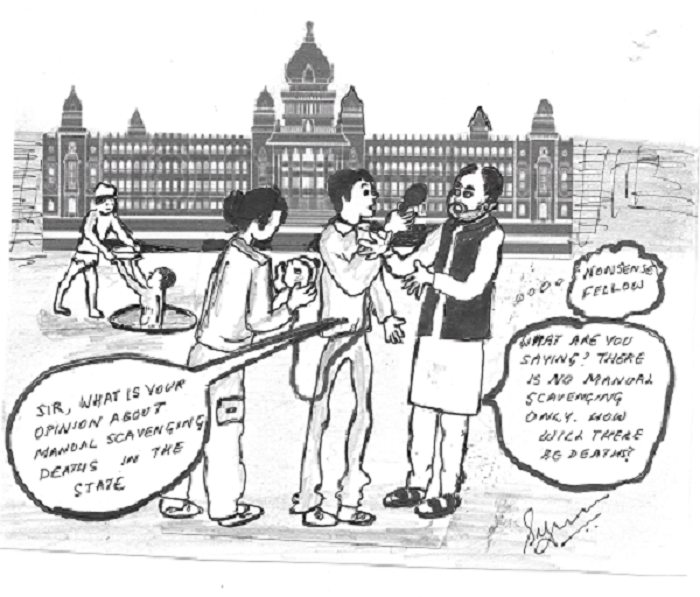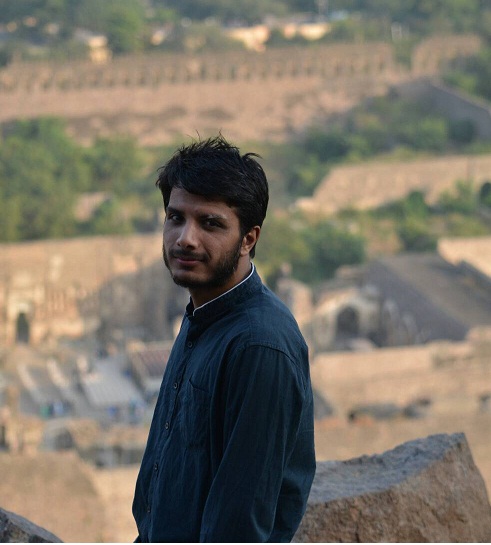Dr. Sylvia Karpagam
On the pretext of open defecation, two dalit children, Avinash and Roshni, age 10 and 12, were brutally murdered1 on the 25th of September 2019, in Shivpuri, Madhya Pradesh, with the girl child being molested2 before being murdered. At the same time, the Prime minister of the country was receiving an award3 for the Swachh Bharat Abhiyan which aims to make India “completely free of open defecation”. This award has been criticised4 in many circles, not in small reason for the prolonged communication blockadeand denial of basic rights to the citizens of Kashmir, by the current government.

An NDTV debate5 on 26th September 2019 called “Left Right and Centre”exposed two diametrically opposing ideologies. The straight-faced Geeta Bhat said that more toilets should be built by a government that”should have been more accountable’. She also made it a point to mention that the accused was not ‘mentally balanced’. Rahul Sonpimple, the other panellist, asked a more heart wrenching question. He said “Will my people who have been made to do manual scavenging for generations now be killed for open defecation?” He quotes from the book6 “Where India Goes: Abandoned Toilets, Stunted Development and the Costs of Caste” by Diane Coffey and Dean Spears, who work at the Research Institute for Compassionate Economics (RICE). He says that the book attributes open defecation to “upper” caste people not using toilets and preferring open defecation as part of their purity/pollution beliefs. This was also highlighted7 in a book review in Velivada.
The book has been lauded for bringing the issue of open defecation and its inevitable link with caste out onto the discussion table, particularly its effect on stunting in children.It is however important to look at the book critically so one doesn’t fall into some traps that the book lays.
The book starts with an anecdote of “Ramila’s baby” (one of 20 infants followed up by the first author Diane) and makes very linear associations between the baby being 2.5 kg, getting sick with diarrhoea, being advised against breast feeding by a “rickshaw wala” doctor, drops of Pepsi, oral rehydration powder, open defecation, the death of the baby and subsequent building of a latrine that was dysfunctional. The rest of the book continues along these same lines and reaches the conclusion that caste is at the bottom of India’s open defecation ‘puzzle’.
This, by itself, is not untrue, but the point is that caste, if probed, will be found, along with gender, as the cause for most of India’s problems– sexual violence, landlessness, poor labour laws, poverty, wealth inequality, illiteracy, maternal deaths, child deaths, poor health, open defecation, stunting etc. In an attempt to simplify disease transmission and by projecting stunting as a direct consequence of open defecation, the authors resort to means and methods that are problematic and likely, dangerous.
The authors say in the book “Naina (the baby) died while Ramila (the mother) was defecating in the open, but if Naina’s diarrhoea was caused by fecal germs, as we suspect, they probably came from someone in another family”. What they mean is that germs spread from open defecation and cause disease, but one need not necessarily be infected by one’s own excreta but by others who defecate in the open. These statements, with a combination of poor understanding of disease transmission, and the frail sensibilities of dominant caste groups, can put some communities (we all know which) at risk of being held responsible/accused/harassed/shamed/targeted/murdered for ‘transmitting’ disease.
The authors go on to demonstrate links between open defecation and cognitive development in two children – Arun and Anil. Arun, because he and his mother spent his early years at the open defecation free maternal home, was found to have impressive cognitive development. His counterpart Anil, having failed to be protected from open defecation, has poor cognitive development. One can see the fallacy of this kind of linear, albeit sensational argument.
According to the data they present, children in India are shorter on average than children in sub Saharan Africa who are poorer on average. Then they go on to link these outcomes to open defecation in India. Stunting in Indian children could be due to poor protein intake because of the unaffordability of eggs and criminalisation of beef; cereal heavy government schemes; poor access to milk and milk products; India’s vegetarian agenda; corporatisation of government schools and pre-schools etc. Does caste operate in the calculation of poverty lines, which could be the ‘real’ problem? It does, but the authors don’t want to say that poor nutrition, often linked to caste, could be the cause of stunting. Children who are better nourished also grow up stronger, taller, with more immunity, better able to work and likely to move to better localities as adults. If caste was addressed, say through reservation, people would have better living circumstances, better wages, better education, more land, more food, lesser anemia, better water quality and therefore reduced stunting. . Not long ago, research attributed teenage pregnancies to stunting8. Another study9 in 2016 links maternal health literacy with early child nutritional status. Women have confessed to catching up on gossip with their friends when they go out to defecate in the open or fill water from public taps. Should this be factored into policy making?
A study10 published in the Lancet found that children who received nutrition were taller by year two than children who didn’t, even if the second group received water, sanitation and handwashing interventions either individually or in combination. What this highlights is the enormous importance of nutrition in addressing stunting, without in anyway undermining the importance of other interventions.
The book discusses another “unpredictable Indian nutritional puzzle”, documented by Angus Deaton and Jean Drèze – that the average calorie intake in India has been declining since the 1980s.Using data from the National Sample Survey (NSS) they computed that, in 1983, the average person in rural India ate 2,240 calories per day. By 2005, this fell by almost 200 calories to 2,047 calories per person per day. The question they ask is “How could it be that a poor population, upon becoming richer, is eating less?” They then go on to answer the question themselves. Not surprisingly, even this is laid at the doorstep of open defecation. According to them open defecation has been declining, leading to lesser exposure to disease and better intestines. These in turn lead to better food absorption because of which people choose to eat fewer calories so that the money spent on food could be used for something else! At this rate, the authors could pretty much link every problem of India to open defecation!!
Calories need not be the only measure of food quality. Indians with better income could be investing more in superior quality proteins such as from animal foods, which may have been unaffordable in the days of poverty, with a predominantly cereal based diet.
Deaton and Dreze pretty much say so themselves “Although the number of calories is important, so are other factors, such as a balanced diet containing a reasonable proportion of fruits, vegetables, and fats (not just calories from cereals), and various determinants of the need for and retention of calories, including activity levels, clean water, sanitation, hygiene practices, and vaccinations. Because of changes in these other factors, the fact that people are increasingly moving away from a diet that is heavy in cereals does not imply that the nutritional status will automatically get worse.”
Swachh Bharat shouldn’t be only about ending open defecation. It should be about curbing industrial waste causing heavy metal contamination of our underground water and crops; preventing untreated sewage being discharged by influential residential apartments; giving more teeth, infrastructure and resources to the pollution control boards; getting dominant caste people to clean their own toilets; and waste segregation, apart from other things. The sanitation workers, predominantly dalit and on contract, continue to be paid miserable wages, abused and harassed, with their livelihoods depending on the whims of contractors and disinterested municipal bodies.
Indians don’t like toilets in their houses because of their deep-rooted need to, physically, symbolically and socially maintain an exaggerated distance from excreta and those people who handle or have handled excreta. Manual scavenging, in different parts of India, continues to be perpetrated by a devious combination of harassment, abuse, social boycott and obstruction to upward mobility – a collusion between the gram panchayat, the local municipality, the police, the hospital, the fire services etc. to erase all records of death due to this obnoxious practice. The government, because it has denied the existence of manual scavenging, doesn’t want these deaths to be recorded as manual scavenging. Now, as State after State in India rushes to claim Open Defecation Free (ODF) status, it replays the same denial and erasure seen towards manual scavenging by the government. Targets and deadlines, which push issues underground are a dangerous way of addressing social issues.
The book shows that toilets are actually rejected by dominant castes and that the ‘lower’ castes imitate this rejection behaviour. This is useful data and can be used to hold dominant caste groups responsible for the continued perpetration of open defecation. The SQUAT (sanitation, quality, use, access and trend) survey also offers useful data.
It is well known among public health and other activists that government constructed toilets are often unused, but the authors make it appear like this is a new truth they have only just discovered.They believe they have unravelled a puzzle and ‘discovered’ caste with their book being dotted with several ‘aha’ moments.
Using the Indian government’s National Family Health Survey data, the research team have documented that Muslim babies in India are more likely than Hindu babies in India to survive childhood. They naturally attribute this ‘Muslim paradox’ to open defecation vs the use of toilets. Apart from the use of toilets, aren’t there differences in eating practices, culture, customs, attitude to girl children etc. between Hindus and Muslims which could contribute to a difference in child growth? Are Muslims less likely to have a son preference? How does this translate into feeding and care practices? Are Muslim families more likely to eat nutritionally superior animal source foods? There is anecdotal evidence of better personal hygiene among Muslim mothers. Does this translate to fewer infections? Is being Muslim itself a protective factor against disease?
It is well known that eating sufficient amounts of animal source foods contributes to improved heights and weights. No statistical analysis has been made on how beef bans in State after State in India is causally linked to stunting (and cognitive development). In the entire book there is no discussion of animal foods and how systematic caste based denial of that to communities has led to generations of stunting.
The deeper point that Rahul Sonpimple brings out is casteist agenda of dominant caste groups to reinforce the association of dalits with excreta –as seen in daily descriptions and language used by the dominant castes against the dalits. It’s a psychological need to keep the ‘untouchables’ perpetually linked to excreta and defecation. So whether a dalit chooses to move away from excreta by avoiding open defecation (or manual scavenging), he or she will still be the victim of it. For dominant caste Hindus who are inflamed by any step towards modernity or development by dalits, even a dalit owning or using a toilet can be a red flag – as an attempt to thwart existing caste hierarchies. Denying dalits a toilet can be one way of maintaining status quo. This can be further reinforced by denying them a toilet and then beating them for open defecation. A dalit child cannot be beaten by dominant castes for not eating healthy food, but she can be beaten for open defecation. That is why the doorstep at which stunting is placed is important.
That sanitation is a problem in India is undeniable. That poor sanitation has to be addressed and causes disease is also undeniable. But making it about open defecation is a problem because the solution then becomes to prevent open defecation, by any means. The book has calls for ‘sanitation senas’ or ‘foot soldiers’ or ‘swachhatadoots’. In India’s class and caste context, these calls have a way of taking a vicious path of their own.Along with “love jihad” and “gauraksha”, (im)moral brigades have now taken up the mantle of Swacch Bharat. Dalit children like Avinash and Roshni then become the inevitable victims, stunting or no stunting.
~
Notes
1. “India: Two held for killing children for ‘defecating in the open’ BBC news” 26th,September, 2019https://www.bbc.com/news/world-asia-india-49835830
2. Gunjan RK “Not Just Open Defecation, Kin of Dalit Children Allege Molestation Too Led to Gruesome MP Murder”, News 18.com, 29th September 2019,https://www.news18.com/news/india/not-just-open-defecation-kin-of-dalit-children-allege-molestation-too-led-to-gruesome-murder-in-mp-2327103.html
3. “PM Modi receives Global Goalkeeper award for Swachh Bharat Abhiyan, says people in India behind its success”, India Today web desk, 25th September 2019https://www.indiatoday.in/india/story/pm-modi-receives-global-goalkeeper-award-for-swachh-bharat-abhiyan-1602843-2019-09-25
4. Vijayan S and Sethi AS “The Gates Foundation shouldn’t give an award to Narendra Modi” The Washington Post, 7th September 2019,https://www.washingtonpost.com/opinions/2019/09/06/gates-foundation-shouldnt-give-an-award-narendra-modi/
5. “Just 10 and 12, two children beaten to death for open defecation” NDTV, 26th September, 2019, https://www.ndtv.com/video/news/left-right-centre/just-10-and-12-two-children-beaten-to-death-for-open-defacation-528215
6. Coffey D & Spears D “Where India Goes: Abandoned Toilets, Stunted Development and the Costs of Caste” Diane Coffey and Dean Spears, Harper Collins Publishers, India, March 2017
7. Dahiwale M “Book Review – Where India Goes: Abandoned Toilets, Stunted Development and the Costs of Caste”, Velivadahttps://velivada.com/2017/08/26/book-review-india-goes-abandoned-toilets-stunted-development-costs-caste/
8. Singh J “Study reveals link between teenage pregnancy and child stunting” The Hindu BusinessLine, 17th May 2019, https://www.thehindubusinessline.com/news/science/study-reveals-link-between-teenage-pregnancy-and-childs-stunt-growth/article27162773.ece
9. Johri M “Maternal health literacy is associated with early childhood nutritional status in India’ J Nutr. 2016 Jul;146(7):1402-10. https://www.ncbi.nlm.nih.gov/pubmed/27306895
10. Luby et al “Effects of water quality, sanitation, handwashing, and nutritional interventions on diarrhoea and child growth,in rural Bangladesh: a cluster randomised controlled study” The Lancet, Volume 6, Issue 3, PE302 – E315, March 01, 2018 http://www.thelancet.com/journals/langlo/article/PIIS2214-109X(17)30490-4/fulltext
11. Deaton, A. and J. Drèze, 2009. ‘Food and nutrition in India: Facts and interpretations’, Economic & Political Weekly, pp. 42–65.https://www.epw.in/journal/2009/07/special-articles/food-and-nutrition-india-facts-and-interpretations.html
~~~
Dr Sylvia Karpagam is a public health doctor and researcher working on the Right to Food and Right to Health. campaigns.
Illustration by Sylvia Karpagam.









